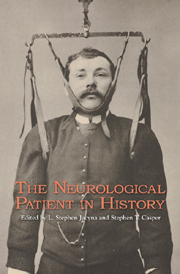Book contents
- Frontmatter
- Contents
- Preface
- Acknowledgments
- Introduction
- Part One Medicine Constructs the “Neurological Patient”
- Part Two Public and Private Constructions of the “Neurological Patient”
- 3 Speaking for Yourself: The Medico-Legal Aspects of Aphasia in Nineteenth-Century Britain
- 4 The Spouse, the Neurological Patient, and Doctors
- Part Three Patient Groups Construct the “Neurological Patient”
- Part Four The Patient Constructs the “Neurological Patient”
- Part Five Historians Construct the “Neurological Patient”
- Bibliography
- List of Contributors
- Index
4 - The Spouse, the Neurological Patient, and Doctors
from Part Two - Public and Private Constructions of the “Neurological Patient”
Published online by Cambridge University Press: 12 September 2012
- Frontmatter
- Contents
- Preface
- Acknowledgments
- Introduction
- Part One Medicine Constructs the “Neurological Patient”
- Part Two Public and Private Constructions of the “Neurological Patient”
- 3 Speaking for Yourself: The Medico-Legal Aspects of Aphasia in Nineteenth-Century Britain
- 4 The Spouse, the Neurological Patient, and Doctors
- Part Three Patient Groups Construct the “Neurological Patient”
- Part Four The Patient Constructs the “Neurological Patient”
- Part Five Historians Construct the “Neurological Patient”
- Bibliography
- List of Contributors
- Index
Summary
Introduction
The period spanning the late nineteenth and early twentieth centuries might be described as the age of the “specialist patient,” if only in response to the emergence of institutions and specialist doctors that required such bodies. In the case of nervous disorders, the Great War aided and abetted this development. The neurological patient of this paper—the Anglophile Frenchman Jacques Raverat (1885–1925)—and his illness narrative are also intertwined with the Great War. It was his failed attempt to enlist in the armed forces that precipitated his diagnosis by a specialist in nervous diseases of a central nervous system disease known as disseminated sclerosis. Patients such as Jacques, and those that returned from the war with head injuries and shell shock, were, like many with chronic or debilitating conditions, cared for in their homes, not hospitals. They were attended by family members and not by qualified specialist doctors and nurses. Caregivers were frequently spouses such as Gwen Raverat (1885–1957), whose chosen career was wood engraving, not caregiving. Malcolm Salaman, a well-regarded art scholar and critic, considered her “the most gifted and original artist using the medium creatively.”
These caregivers and modes of informal care often are absent from the literature of the history of medicine because, in the face of the welfare state, their provision was thought to have been dwarfed and subsumed by the political state. Their role was overlooked or, at most, considered through the prism of their absorption into formal systems of care. In the Western world, the late nineteenth to early twentieth century might be described as a period that saw the dissolution of informal care; its final blow was the introduction of the United Kingdom National Health Service.
- Type
- Chapter
- Information
- The Neurological Patient in History , pp. 81 - 106Publisher: Boydell & BrewerPrint publication year: 2012

